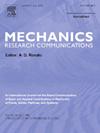场波动弹塑性自洽晶体塑性:在轧制、再结晶和拉伸过程中预测织构演变的应用
IF 2.3
4区 工程技术
Q3 MECHANICS
引用次数: 0
摘要
本文将平均场弹塑性自洽(EPSC)模型提升到高阶模型,以晶粒内部应力场的二阶矩为基础,计算晶格旋转速率的二阶矩和由此引起的粒内取向偏差扩展。新配方被命名为场涨落(FF)-EPSC。通过模拟过渡带和晶界成核机制以及控制再结晶晶粒生长的蓄能,利用计算得到的晶内取向偏差扩展来建立晶粒碎裂模型以改进变形织构演化的预测,并建立再结晶模型以实现再结晶织构演化的预测。FF-EPSC结合了基于位错密度的硬化规律,用于滑移抗力的演化,以及影响滑移系统激活的背应力规律。通过对铝合金(AA) 5182-O的拉伸后静态再结晶和轧制后无间隙钢的静态再结晶的模拟来验证模型的准确性。值得注意的是,该模型在预测变形织构之后预测了再结晶织构,同时揭示了过渡带和晶界形核机制之间的权衡。此外,在AA5182-O拉伸后,预测的晶粒内取向偏差扩展与相应的测量结果吻合良好。在Abaqus中,将FF-EPSC模型作为用户材料子程序集成到隐式有限元(FE)方法中,使每个积分点嵌入FF-EPSC本构律,便于预测复杂边界条件下几何形状的变化。采用FE-FF-EPSC模型对AA6022-T4圆柱杯的轧制、再结晶、深拉深过程进行了数值模拟。本文章由计算机程序翻译,如有差异,请以英文原文为准。
Field fluctuations elasto-plastic self-consistent crystal plasticity: Applications to predict texture evolution during rolling, recrystallization, and drawing processes
This paper advances a mean field elasto-plastic self-consistent (EPSC) model to a higher-order model, calculating the second moments of lattice rotation rates and resulting intragranular misorientation spreads, based on the second moments of stress fields inside grains. The novel formulation is named field fluctuations (FF)-EPSC. The calculated intragranular misorientation spreads are used to conceive a grain fragmentation model to improve the predictions of deformation texture evolution and a recrystallization model to enable the predictions of recrystallization texture evolution, by modeling transition-bands and grain boundary nucleation mechanisms along with stored energy to govern recrystallized grain growth. The FF-EPSC incorporates a dislocation density-based hardening law for the evolution of slip resistance and a backstress law to influence the activation of slip systems. Simulations of tension followed by static recrystallization of an aluminum alloy (AA) 5182-O and rolling followed by static recrystallization of an interstitial-free steel were used to benchmark the accuracy of the model. Remarkably, the model predicted recrystallization textures after predicting the deformation textures while revealing the tradeoffs between transition-bands and grain boundary nucleation mechanisms. Moreover, predicted intragranular misorientation spreads after tension of AA5182-O agreed well with the corresponding measurements. The FF-EPSC model was further integrated in the implicit finite element (FE) method as a user material subroutine in Abaqus to facilitate predicting geometrical shape changes under complex boundary conditions with every integration point embedding the FF-EPSC constitutive law. The FE-FF-EPSC model was applied to simulate the sequence of processes involving rolling, recrystallization, and deep-drawing of an AA6022-T4 cylindrical cup.
求助全文
通过发布文献求助,成功后即可免费获取论文全文。
去求助
来源期刊
CiteScore
4.10
自引率
4.20%
发文量
114
审稿时长
9 months
期刊介绍:
Mechanics Research Communications publishes, as rapidly as possible, peer-reviewed manuscripts of high standards but restricted length. It aims to provide:
• a fast means of communication
• an exchange of ideas among workers in mechanics
• an effective method of bringing new results quickly to the public
• an informal vehicle for the discussion
• of ideas that may still be in the formative stages
The field of Mechanics will be understood to encompass the behavior of continua, fluids, solids, particles and their mixtures. Submissions must contain a strong, novel contribution to the field of mechanics, and ideally should be focused on current issues in the field involving theoretical, experimental and/or applied research, preferably within the broad expertise encompassed by the Board of Associate Editors. Deviations from these areas should be discussed in advance with the Editor-in-Chief.

 求助内容:
求助内容: 应助结果提醒方式:
应助结果提醒方式:


